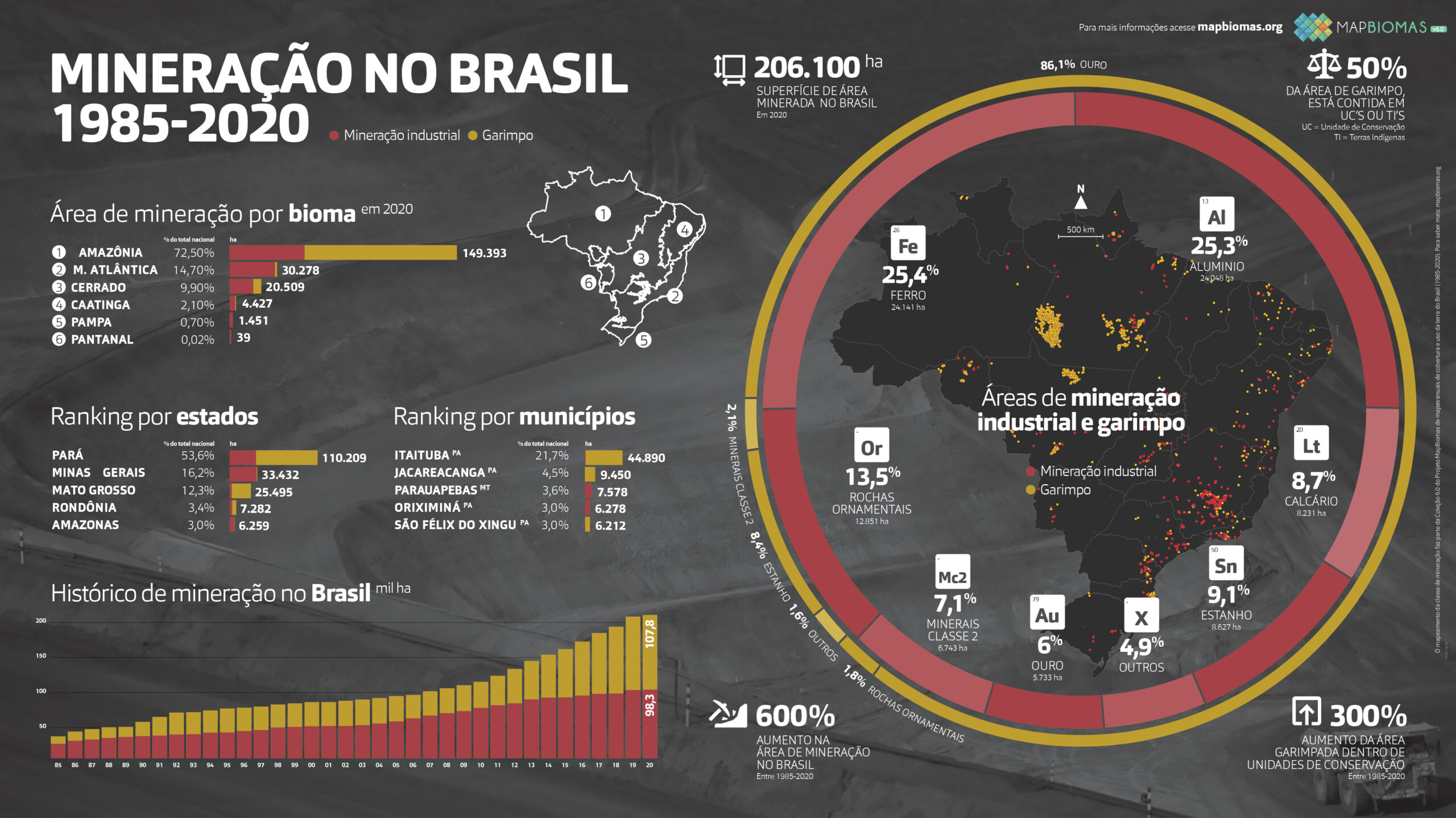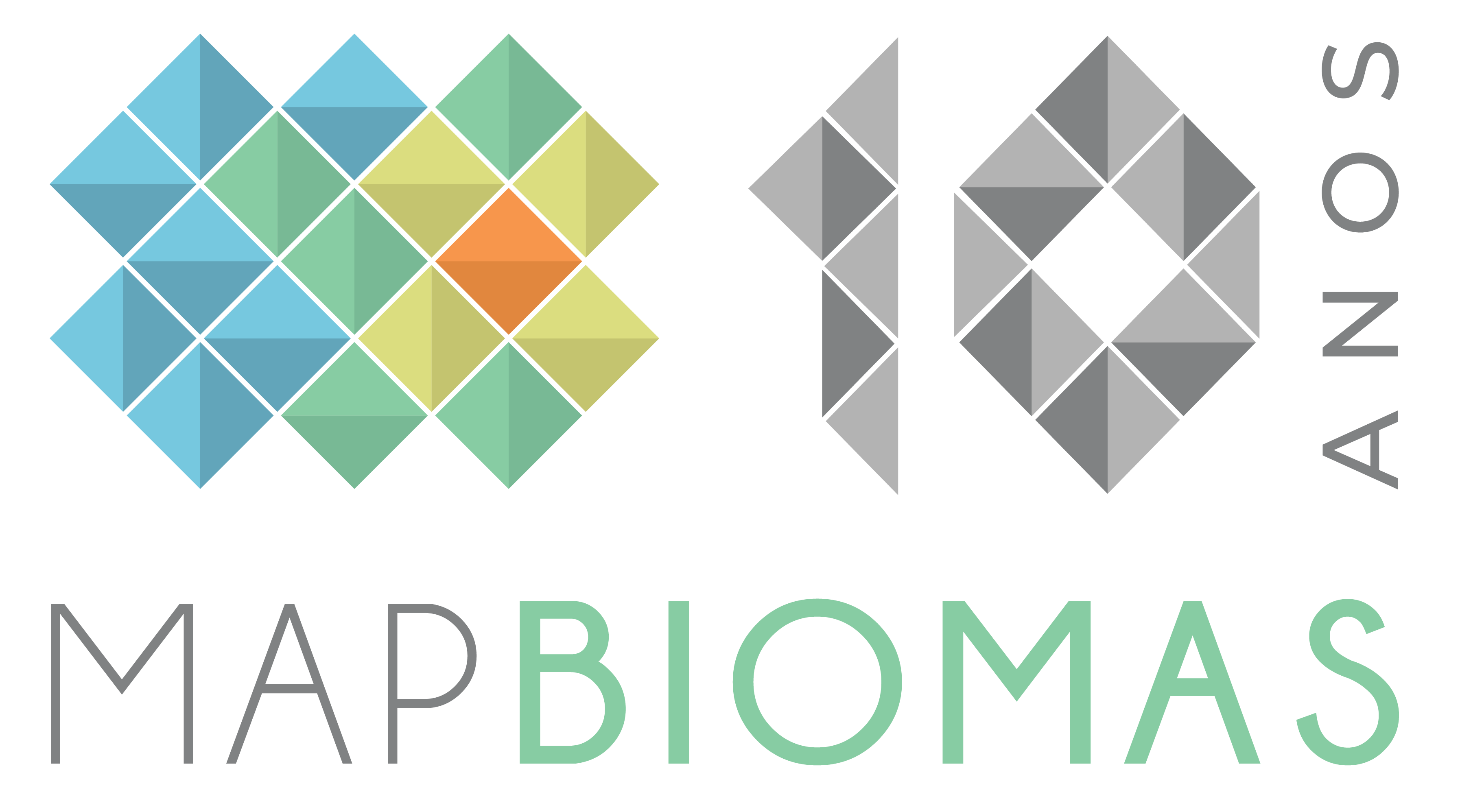Artisanal mining already occupies a larger area than industrial mining e avança sobre terras indígenas e unidades de conservação na Amazônia
Between 1985 and 2020, the mined area in Brazil grew sixfold, according to the most recent temporal analysis of the Brazilian territory conducted by MapBiomas. The data, resulting from the analysis of satellite images with the aid of artificial intelligence, reflects the jump from 31,000 hectares in 1985 to a total of 206,000 hectares last year. Much of this growth occurred through expansion in the Amazon rainforest.
In 2020, three out of every four hectares mined in Brazil were located in the Amazon. The biome accounts for 72.5% of the total area, including both industrial mining and artisanal mining. This amounts to 149,393 hectares, of which 101,100 hectares (67.6%) are from artisanal mining. Nearly all (93.7%) of Brazil's artisanal mining is concentrated in the Amazon. As for industrial mining, the biome represents almost half (49.2%) of the area occupied by this activity in the country.
In addition to being concentrated in the Amazon, artisanal mining is also characterized by strong expansion in recent years. Artisanal mining activity surpassed the area associated with industrial mining in 2020: 107,800 hectares compared to 98,300 hectares, respectively. While the expansion of industrial mining occurred incrementally and continuously at a rate of 2,200 hectares per year with no major variations between 1985 and 2020, the situation was different for artisanal mining. Between 1985 and 2009, the growth rate was low, around 1,500 hectares per year, but from 2010 onwards, the expansion rate quadrupled to 6,500 hectares per year.
The expansion of artisanal mining coincides with encroachment upon indigenous territories and conservation units. From 2010 to 2020, the area occupied by artisanal mining within indigenous lands increased by 495%; in the case of conservation units, the growth was 301%. Last year, half of the national artisanal mining area was within conservation units (40.7%) or indigenous lands (9.3%). The largest areas of artisanal mining in indigenous lands are in Kayapó territory (7,602 hectares) and Munduruku territory (1,592 hectares) in Pará, and Yanomami territory (414 hectares) in Amazonas and Roraima. Among the 10 conservation units with the highest artisanal mining activity, eight are located in Pará. The three largest are the Tapajós Environmental Protection Area (34,740 hectares), the Amaná National Forest (4,150 hectares), and the Rio Novo National Park (1,752 hectares).
"For the first time, the evolution of mined areas is presented to society, showing the expansion across the entire Brazilian territory since 1985. These are unprecedented data that allow us to understand the different dynamics of industrial mining and artisanal mining areas and their relationships, for example, with commodity prices, conservation units, and indigenous lands," said Pedro Walfir, professor at UFPA and coordinator of the Mining Mapping at MapBiomas.
In terms of total mined area, the three largest states are Pará (110,209 ha), Minas Gerais (33,432 ha), and Mato Grosso (25,495 ha). In the case of Pará, the majority of this area is occupied by artisanal mining (76,514 ha, compared to 33,695 ha of industrial mining). In Minas Gerais, almost all of it is occupied by industrial mining (32,785 ha). Mato Grosso follows the pattern of Pará, with a predominance of artisanal mining (22,987 ha).
When industrial and artisanal mining areas are combined, only two states are present in the ranking of the top 10 municipalities with the largest mined area: Pará and Mato Grosso. The first, second, and third places – Itaituba (44,854 ha), Jacareacanga (9,450 ha), and Parauapebas (7,558 ha) – are in Pará. The sixth place – Peixoto de Azevedo (5,736 ha) – is in Mato Grosso. Minas Gerais is not included in the ranking of municipalities with the largest mined area when both artisanal and industrial mining areas are grouped together.
Municipalities
The map of municipalities with the highest artisanal mining activity is slightly different. Without exceptions, all 10 municipalities with the largest artisanally mined area are located in southern Pará and northern Mato Grosso, with Itaituba, Jacareacanga, and São Félix do Xingu ranking first, second, and third, respectively. This concentration does not appear in the case of the top 10 municipalities with the largest industrial mining area, which are scattered across Pará, Minas Gerais, and Amazonas. However, the top three – Parauapebas (6,706 ha), Oriximiná (6,278 ha), and Paragominas (5,402 ha) – are all in Pará, followed by a significant contribution from Minas Gerais, with Paracatu (3,116 ha), Itabira (2,963 ha), and Congonhas (2,405 ha).
Artisanal mining and industrial mining also differ in terms of the mineral extracted. While iron production (25.4%) and aluminum (25.3%) account for half of the industrial mining area, 86.1% of the mined area is related to gold extraction.
In terms of total mined area, the Amazon leads with 72.5% (149,393 ha), while the Atlantic Forest is a distant second, with 14.7% (30,278 ha), followed by the Cerrado, with 9.9% (20,509 ha), Caatinga (2.1% - 4,427 ha), Pampa (0.7% - 1,451 ha), and Pantanal - 0.02% (39 ha). In industrial mining, the Amazon contains 49.2% (48,342 ha) of the total area, the Atlantic Forest accounts for nearly one-third of the area occupied (29.7% - 29,157 ha), followed by the Cerrado (15.7% - 15,392 ha), Caatinga (4% - 3,950 ha), and the Pampa (1.5% - 1,451 ha). With the exception of the Amazon, the area of artisanal mining is not predominant in the other biomes: 4.7% (5,117 ha) in the Cerrado, 1% (1,121 ha) in the Atlantic Forest, and 0.4% (477 ha) in the Caatinga.
"The products of mining are essential for the development of a low-carbon economy. We hope that this data will contribute to the definition of strategies to end illegal activities and establish mining on sustainable bases, respecting protected areas and the rights of indigenous peoples, and meeting the highest standards of care for biodiversity, soil, and water," says Tasso Azevedo, General Coordinator of MapBiomas.
Access the main data from the survey on the Fact Sheet here.



